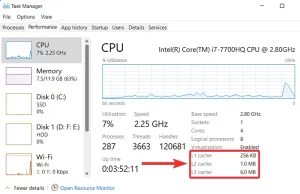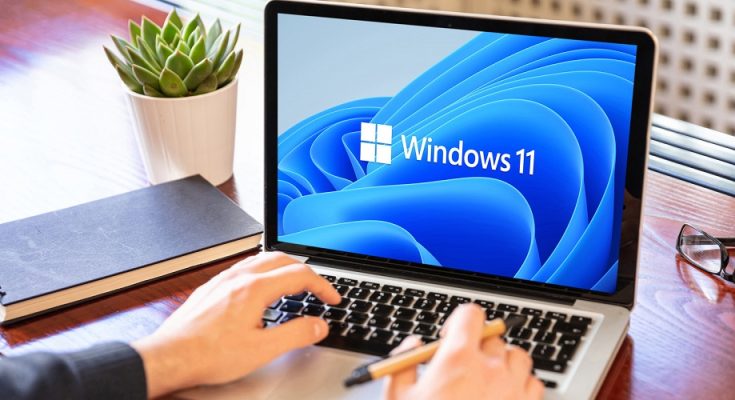Cache files are required for you to be able to use your computer faster. But sometimes, you need to clear the cache on Windows 11 PC. This is especially true if you can’t load a new or updated version of a webpage or if you need more storage space or RAM. Getting rid of cache files can also make your PC run faster, especially if it frees up a lot of RAM and storage space. This is also one of the reasons why you need to restart your PC every so often, as that clears the system cache. But don’t worry; getting rid of cache files on your computer is easy. This article will tell you about the different kinds of caches on your computer and how to get rid of them. So, let’s get going without further ado.
What’s Cache?
A cache (pronounced “cache”) is a fast, specialized piece of hardware or software that stores data and instructions that are often asked for. This helps websites, apps, services, and other parts of your system load faster. In addition, the cache makes it easy to get to the information you use most often. Cache memory is not the same as Cache files. Cache files are often used in multiple programs, like PNGs, icons, logos, shaders, and more. Most of the time, these files are hidden and stored on your hard drive.
On the other hand, cache memory is faster than either your main memory or RAM. This greatly reduces the time it takes to access data because it is much faster and closer to your CPU than your RAM. In addition, cache memory helps your processor do calculations faster, which makes your PC go faster. Cache memory is a type of storage that isn’t very big, and it has three levels:
Level 1 (L1) – L1 is the smallest and fastest cache. Its size is usually between 8KB and 64KB.
Level 2 (L2) and Level 2 (L3) – Compared to L1, L2, and L3, caches are bigger and move more slowly.
The Windows Task Manager lets you see the size of your cache.

Why Should Clear Cache On Windows 11?
Caches Can Be Corrupted – Caches can get messed up. If cache files get messed up, an app or your system might act strangely or even crash. So before you start using your PC again, you should get rid of these corrupted cache files.
Clear Storage Space – Cache files are usually small, but if you have many of them that have been there for a long time, they can take up more space on your computer than you might think. The solution is to get rid of this big group of cache files so that your device has more space.
Performance – The size of your cache files can directly affect the speed of your system as a whole. If your system’s cache is fuller than it should be, it may run slower than you would normally expect.
Outdated Information – Sometimes, older cache files can stop you from using the latest version of apps or websites on your system. You can solve this by clearing the files in your cache.
Is Clearing Cache Safe?
It’s safe to clear the cache on Windows 11 PC. This is because clearing the cache is a temporary fix if you plan to use the apps or websites again. At some point, these sites and apps will store data on your computer again. Even so, the cache stores optional files, and deleting these files will stay the same as how the apps or websites generally work. But it will change how fast these apps or websites load. To be clear, these load times will go down once the app or website rebuilds caches on your system again.
How To Easily Clear The Cache On Windows 11?
It takes less time to clear the cache on Windows 11 than you might think. This is because cache files on Windows 11 can come from different places so they can be of different types. Unfortunately, this also makes your cache files spread over your system. Follow the step-by-step instructions for each type of cache you want to get rid of on your PC.
Delete Temporary Cache Files
1 – Press Windows + R on your keyboard to open the Run command.
2 – Type “%temp%” and hit the “Enter” key on your keyboard.
3 – Now, click the icon with three dots.
4 – Click the “Select all” button.
5 – Click the trash bin icon.
6 – If you see this message, check the “Do this for all current items” box and click “Continue.”
7 – If you see the next message, check the box that says “Do this for all current items” and click “Skip.”
All done. The Temp folder’s cache files will now be deleted.
Clear Temporary Files In System Storage
Some cached files, like the Temp folder, might be in a different place. Follow the steps below to get rid of these strewn-about system cache files in settings.
1 – Press the Windows key on your keyboard to open the start menu.
2 – Search for “Storage settings” in the Start menu and click the same result.
3 – Click the “Temporary Files” button.
4 – Go to the bottom of the page and click the checkboxes next to the files you want to delete.
Note: Short description comes after each file type. Read this description before you add the file type to the list of files you want to delete.
5 – Now click ‘Remove files.’
6 – Click “Continue” to make sure your choice is correct.
Your device will now get rid of the files you chose.
Disk Cleanup
Disk Cleanup is a built-in tool from Microsoft that can scan your system for cache and other temporary files. This includes Windows error reports, DirectX Shader Cache, Delivery Optimization Files, and more. First, look at how the Disk Cleanup tool can be used.
1 – Press the Windows key on your keyboard to open the start menu.
2 – Search for “Disk Cleanup” in the “Start” menu and click the same result.
3 – Click the menu that drops down.
4 – Click the drive you want to clean up.
5 – Go to the bottom of the page and click the checkboxes next to the files you want to delete.
Note: Short description comes after each file type. Read this description before you add the file type to the list of files you want to delete.
1 – Click the OK button.
2 – Click ‘Delete Files.’
3 – If you see this message, check the box next to “Do this for all current items” and click “Continue.”
4 – Wait until the cleaning up is done.
5 – The files you chose to delete have now been taken off your system. You can also clean up system files with the Disk Cleanup tool. Follow the steps below to get rid of system files.
6 – Click the “Clean up system files” button in the Disk Cleanup tool.
7 – Choose the Drive where your system files are stored. This will be called the “C” drive on most systems.
8 – Go to the bottom of the page and click the checkboxes next to the files you want to delete.
9 – Hit the “OK” button.
10 – Press the “Delete Files” button.
Now, the system files you chose will be deleted.
Flush DNS
The Domain Name System, or DNS, is like a phone book for the websites you visit on your computer. In particular, DNS turns domain names, like “www.google.com,” into IP addresses (8.8.8.8). Even though the DNS cache makes it easy for your computer to load websites, the number of cache files may have grown over time. In the worst cases, you may also experience DNS cache poisoning, which happens when a malicious agent attacks and changes the IP addresses stored. It makes sense to flush the DNS in these situations. So let’s look at what you can do.
1 – Press the Windows key on your keyboard to open the start menu.
2 – Look for “cmd” in the Start menu and click it when it appears in the search results.
3 – Type the following command into Command Prompt and press Enter when you’re done.
ipconfig /flushdns
Now, the DNS cache has been wiped clean.
Clear Microsoft Store’s Cache
Microsoft Store stores cached data on your PC like other apps on your system. You can also delete these files using the wssreset.exe file. This can help you if you’re having trouble buying things, downloading things, or if Store apps won’t load. Follow these steps to clear the cache on your Windows 11 Microsoft Store.
1 – Press Windows + R on your keyboard to open the Run command window.
2 – Type “wsreset.exe” and hit the “Enter” key on your keyboard.
Well, the wsreset.exe file will clear the Windows 11 Microsoft cache without asking for permission and then close itself.
Clear Web Browser Cache
Web browsers store “static assets” of the websites you often visit on your computer so you can get to them faster the next time you go there. Static assets are the parts of a website that stay mostly the same from one visit to the next. But it’s possible that the version of a website’s cached data on your computer needs to be updated. This could also cause problems whenever you try to get to this website. In that case, you should clear your browser’s cache. Let’s look at how to clear the cache on Google Chrome and Mozilla Firefox, two of the most popular PC web browsers on Windows 11.
Google Chrome
1 – Open Google Chrome on your computer and press Ctrl + Shift + Delete. This will open the settings for clearing your browser’s history.
2 – Click “Time range” and choose the time you want to clear Google Chrome’s cache.
3 – Scroll down and make sure that the only box checked is “Cached images and files.”
4 – Click the “Clear data” button.
Now, your Google Chrome cache is gone.
Mozilla Firefox
1 – Open Firefox on your PC and press Ctrl + Shift + Delete on your keyboard. This will open the settings for clearing your recent history.
2 – Click “Time range to clear” and choose the time range for which you wish to clear the cache in your Firefox browser.
3 – Ensure that the “Cache” box is the only one checked.
4 – Click the “OK” button.
And that’s how to clear your PC’s browser cache!
Clear Location Cache
Cache files on your Windows PC to track where you’ve been. Follow these steps to get rid of these files.
1 – To open Settings, press Windows + I on your keyboard.
2 – Click “Privacy & Security” in the sidebar on the left.
3 – Scroll down to the “App permissions” section on the right and click the “Location” option.
4 – Now, scroll down until you find “Location History.” Click “Clear” next to it to get rid of the same.
Your computer’s location cache has been cleared.
Clear Activity History
Windows uses what you’ve done in the past to make your experience more personal. The activity history can include information like the websites you visit or how you use different apps and services on your PC. This history of what you’ve done is tied to your Microsoft account. But if you wish to delete your activity history, you can use the steps in the guide below.
1 – To open Settings, press Windows + I on your keyboard.
2 – Click “Privacy & Security.”
3 – Scroll down to the “Clear activity history” section on the right and click “Clear.”
You can also stop Microsoft from keeping a record of what you’ve done on your device by ensuring the box below is not checked.
Delete Prefetch Files
The Prefetch files were first introduced with Windows XP. They’re used to speed up the time it takes to start your Windows PC. However, if your system is infected with malicious software and you’re having trouble starting up, you should delete the prefetch files.
Note: Remember that the prefetch files help your system start up faster. If you get rid of them, it will change how long it takes to boot up in the future.
Let’s look at how to clear prefetch files in Windows 11.
1 – Press Windows + R on your keyboard to open the Run command window.
2 – Type prefetch into the Run command and press the Enter key on your keyboard. This will delete the prefetch files on its own.
But this can also open the folder for prefetching. In that case, press Ctrl + A on your keyboard to select all files, and then press Delete to get rid of the prefetch files.
Clear File Explorer Cache
File Explorer keeps track of the files and addresses you use most often on your computer. A great example of this is the quick-access menu. You can also delete the cache files that store this information in Windows, just like in other apps. Let’s look at what you can do.
1 – Press the Windows key on your keyboard to open the start menu.
2 – In the “Start” menu, type “File Explorer” and click it when it comes up in the results list.
3 – Click the three-dot icon near the top of the File Explorer window.
4 – Click the “Options” button. This will bring up the options for folders.
5 – In the Privacy section, click the “Clear” button.
Clear System Restore Cache
If you delete the system restore points in Windows 11, the cache files that go with them will also be deleted. But be careful because this method involves removing restore points, which will make it impossible to fix Windows if you get a BSOD in the future. So instead, follow the steps below to make the process easier.
1 – Press the Windows key on your keyboard to open the start menu.
2 – In the Start menu, look for “File Explorer,” and when it comes up, click it.
3 – Click “Configure” in the System Properties.
4 – Click “Delete” in the System Protection menu.
5 – Click “Continue” to move on.
Note: Remember that this will get rid of the restore points. So, you should be careful.
Now, the restore points and the cache files linked to them have been removed.
Delete Cache With Storage Sense Automatically
If you don’t want to delete the different types of caches on your computer one by one, Windows 11 has a feature that does it for you. The name of this feature is “Storage Sense,” which can automatically clear the cache at a set time interval. Let’s look at how Storage Sense in Windows 11 can delete the cache automatically.
1 – Press Windows + I on your keyboard to open Settings, then click “System” in the menu that comes up.
2 – Go down and click “Storage” on your right.
3 – Move down the page and click “Storage Sense.”
4 – Ensure the box next to “Cleanup of temporary files” is checked. Then, click and turn on the switch next to “Automatic User content cleanup” to turn on Storage Sense.
5 – Click the “Run Storage Sense” button and choose how often you want Storage Sense to run.
6 – Choose a good time for the “Delete files in my recycle bin if they’ve been there over” option.
7 – Choose a good time for the “Delete files in my downloads folder if they’ve not been opened for more than” option.
All done. Storage Sense is now turned on and will run based on your set times.
Clear Clipboard Cache
With Windows 11, getting rid of the clipboard cache only takes a few clicks. So let’s look at what you can do.
1 – Press the Windows key on your keyboard to open the start menu.
2 – Search for “Clipboard settings” and click the best result.
3 – Scroll down in the right panel until you see “Clear clipboard data.” Click “Clear” to get rid of it.
Clear Display Cache
On Windows 11, the display cache stores information about your system’s display. This data can be anything, like the last resolution you used, color mode, etc. But display cache has some of the same problems as other types of cache. Also, if your system display is acting up, you might need to clear the cache and reset your display settings. Let’s look at what you can do.
1 – Press the Windows key on your keyboard to open the start menu.
2 – Look for “Registry Editor” in your search results and click it.
3 – Move the cursor to the next path. You can copy and paste the same into the top address bar.
HKEY_LOCAL_MACHINE\SYSTEM\CurrentControlSet\Control\GraphicsDrivers
Note: Before going any further, it’s best to set up a restore point.
4 – Right-click on the “Configuration” key and click “Delete.”
5 – Repeat the step above to delete the “Connectivity” and “ScaleFactors” keys.
Restarting your PC will finish the job.
FAQs:
What’s The Difference Between Cache And Cookies On A Web Browser?
A browser cache saves things like pictures, files, and HTML data for a certain website so that the same website can load faster the next time you go there. On the other hand, cookies are used to store small bits of information, like user names, emails, sign-in information, shopping cart information, etc.
What’s The File Type Of A Cache File?
Most web browsers use the .cache extension to store data that has already been downloaded. Even though this extension is not a file format, it tells the user what the file is used for.
How To Open A Cache File?
It would be best if you had software that can open a Snac-1.3 VDA file to open a cache file. But you can also use online sites like fileproinfo to look at a cache file and see its text.
Is The Cache Memory Fast?
Yes. Cache memory is one of the fastest types of memory on a PC, if not the fastest. It’s even quicker than RAM. This is because the cache is usually a small piece of physical storage close to the CPU. So, it only takes a small number of clock cycles (the CPU’s unit of time) for data to move from the cache memory to the CPU.
What Happens After You Delete Cache On A Web Browser?
When you delete a web browser’s cache, you will see that some settings on certain websites have changed. For example, some sites will also take longer to load. But as time goes on and you return to these sites, the web browser will make the cache files again.



